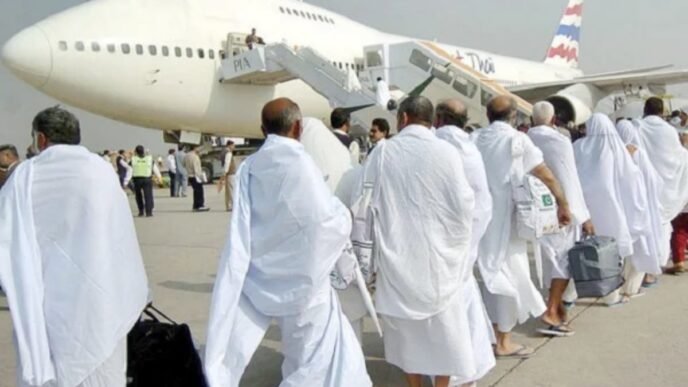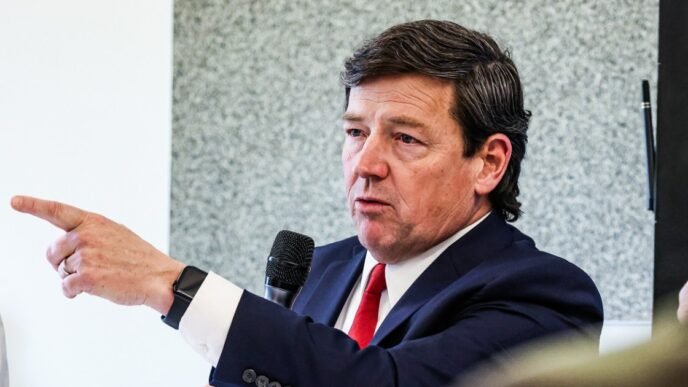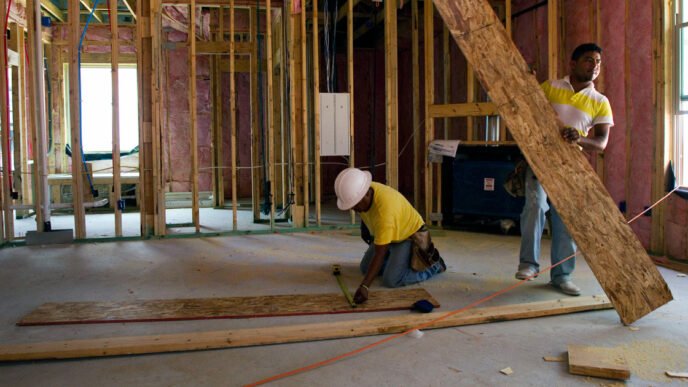President Donald Trump has moved with remarkable speed in his first 100 days, issuing more than 100 executive orders and pushing an agenda that has the potential to rapidly remake America.
That effort comes from some big promises he made on the campaign trail, including to implement tariffs, carry out mass deportations and end major international conflicts.
Here’s a look at many of those promises and whether or not he’s followed through:
Promise: End war in Ukraine on or before Day 1
During his 721-day campaign, Trump consistently promised to end the war in Ukraine. At times, he even went as far as to add that he would end the conflict in 24 hours.
“Before I even arrive at the Oval Office, shortly after I win the presidency, I will have the disastrous war between Russia and Ukraine settled,” he told a rally crowd in Waco, Texas in March 2023, adding, “I will have that settlement done within 24 hours.”
In an interview with former Navy SEAL Shawn Ryan’s podcast in August 2024, he said, “I will have that war settled when I’m president-elect, meaning before I get to office on Jan. 20.”
Status: Failed
One-hundred days into Trump’s second term, the conflict grinds on. In a recent interview with Time magazine, Trump claimed that his campaign rhetoric about the conflict was an “exaggeration and “was said in jest.”
In one of the more memorable days of this administration, Trump and Vice President Vance berated Ukrainian President Volodymyr Zelenskyy in the Oval Office, calling him ungrateful and saying he “disrespected” the U.S.
Still, the president acknowledged during that meeting that ending the war in Ukraine, which has waged for over three years, would be “a very great achievement if we could get this war stopped, and get them back to normalization.”
Promise: End the war in Gaza
Since Hamas terrorists attacked Israel on Oct. 7, 2023, Trump maintained that the attack would not have taken place had he been president at the time. Throughout the campaign, he kept in contact with Israeli Prime Minister Benjamin Netanyahu, even hosting him at his home in Mar-a-Lago last July. And on several occasions, especially when speaking to predominantly Jewish audiences, he promised he would “bring peace back to the Middle East.”
“We’re going to get it to work out,” he told the Israeli-American Council in Washington, D.C. in September. “I’m the candidate of those who want to defend Western civilization, defend Israel and defend the United States of America. When I return to the White House, we will quickly restore stability in the Middle East, and we will return the world to peace.”
Status: Failed
The beginning of 2025 showed promise; before President Trump was sworn in, he dispatched his special envoy to the Middle East, Steve Witkoff, to work with President Joe Biden’s chief negotiator, Brett McGurk. A three-phase ceasefire deal was agreed to on Jan. 15, with Trump, then the president-elect, taking a victory lap.
The deal lasted until March 18, when Israel launched a surprise attack on Gaza and Netayahu announced that Israel had “resumed combat in full force“ against Hamas.
On April 7, during an event with Netanyahu, Trump indicated that the negotiators were close to a deal saying, “Well, I’d like to see the war stop, and I think the war will stop at some point. That won’t be in the too distant future. Right now, we have a problem with hostages. We’re trying to get the hostages out. We got quite a few of them out, but it’s a long process. It shouldn’t be that long.”
Thirty-three Israeli hostages and 1,800 Palestinians were returned during the ceasefire earlier this year; 59 Israelis taken since the start of the Oct. 7 conflict remain in captivity. The Palestinian death toll since the start of the Israel-Hamas war stands at 52,243, according to the Gaza Health Ministry; the Israeli death toll is roughly 1,200 people killed, according to Israeli Foreign Ministry, and 251 people taken hostage.
Promise: Close the border
Immigration has long been one of Trump’s top issues in his campaigns. Throughout the 2024 race, Trump laid out various initiatives aimed at decreasing illegal immigration and the number of undocumented immigrants living in the U.S. But largely, his agenda started with sealing the border — particularly the southern border with Mexico.
Trump held more events focused on immigration than any other one topic, including the economy. At a rally in Aurora, Colo. on Oct. 11, he said, “We will close the border. We will stop the invasion of illegals into our country. We will defend our territory. We will not be conquered. We will not be conquered. We will reclaim our sovereignty.”
Status: Kept
According to U.S. Customs and Border Protection, illegal crossings are at a historic low, dropping from 211,896 in March 2022 to 8,193 in March 2025, a 96% decrease, according to U.S. Customs and Border Protection.
Most recently, Trump took to Truth Social to highlight his accomplishment, writing, “THE SOUTHERN BORDER IS NOW THE STRONGEST AND SAFEST IN USA HISTORY. IT WILL REMAIN SO!!!” and noting “I beat my own record” during an event on April 22, 2025.
Promise: Carry out the largest mass deportation operation in U.S. history
Carrying out mass deportations was a cornerstone of Trump’s 2024 campaign, even though he never provided any specifics on how such an operation would be implemented or paid for.
“I will send Congress a bill to ban all sanctu cities in our country, including Denver, and we will begin the largest deportation operation in the history of the United States,” Trump said at a rally in Aurora, Colo. in October.
On Oct. 27, just days before the election, Trump reiterated during a rally in New York City, “On day one, I will launch the largest deportation program in American history to get the criminals out.”
Status: Jury’s still out
While the administration did begin deportation operations almost immediately, Trump’s deportation numbers have been lower than that of both Biden and Barack Obama during the same time period in their presidencies. But that is largely because the number of border encounters has been significantly lower.
According to Trump’s border czar, Tom Homan, the administration has deported approximately 139,000 people as of April 28.
Trump is also facing multiple legal challenges to his deportation orders, many of which have been stayed by the Supreme Court or other federal courts.
Homan told NBC News on April 28 that he needs more funding from Congress to carry out the president’s vision.
“We need more, more money for beds. We need more money for more officers. We need more money for contractors that come in and do non enforcement jobs and release the law enforcement officers to the street. We need more plane flights. So Congress needs to come through and fund us to keep President Trump’s promise to the American people,” Homan said.
Promise: End birthright citizenship
In 2023, the president put out a video proposing an end to birthright citizenship and banning what he called “birth tourism.”
“On Day One of my new term in office,” he promised, “I will sign an executive order making clear to federal agencies that under the correct interpretation of the law, going forward, the future children of illegal aliens will not receive automatic U.S. citizenship.”
Status: Jury’s still out
The president signed an executive order ending birthright citizenship on his first day in office. But the order almost immediately faced legal challenges, three of which have made it to the Supreme Court. Arguments will be presented on May 15.
Still, the president has expressed confidence that the order will ultimately be upheld.
“I just think that we’ll end up winning that court, in the Supreme Court. I think we’re going to win that case, and I look forward to winning it,” he said in the Oval Office in late Janu. “ We’re the only country in the world that does this. There’s no other country at this level. There’s no other country in the world that does it. It’s crazy.”
At least four lower-court judges have blocked Trump’s plan.
Promise: Impose tariffs and improve the economy
Trump thinks “tariff” is a beautiful word. He said so, repeatedly, during the campaign.
“The word tariff, properly used, is… one of the most beautiful words I’ve ever heard. It’s music to my ears,” he said at a rally in Savannah, Ga. on Sept. 24.
It was part of his effort to convince voters that imposing tariffs would help bring back American manufacturing and create jobs.
“And it will not cause inflation, by the way,” he often added, like he did at during the speech in Savannah.
Trump often oscillated on specifics of his tariff plan, at times promising he would impose an 100% tariff on all cars from Mexico, while at other times proposing 10%-20% tariffs across the board.
At a speech in York, Pa. on Aug. 19, 2024, Trump claimed that imposing tariffs — “a small 10% tariff” — on foreign imports would “allow massive tax cuts for working families, create more than three million American jobs and raise household incomes by 6%.”
Status: Mixed
Trump’s tariffs have been a rollercoaster. Trump imposed tariffs on Canada, Mexico and China. Then he imposed more tariffs on steel and aluminum. Then he paused the tariffs on Canada and Mexico. Then he unpaused them. Then he imposed reciprocal tariffs. Then he rolled them back but increased the tariffs on China.
During his address to Congress in early March, he acknowledged that there would be some pain before the economy adjusted to the tariffs: “Tariffs are about making America rich again and making America great again, and it’s happening, and it will happen rather quickly. There’ll be a little disturbance, but we’re okay with that. It won’t be much.”
There’s been more than a “little disturbance”; his first 100 days have been the worst for the stock market since Richard Nixon’s presidency, with a cliff dive around April 2, Trump’s “Liberation Day.”
Promise: End inflation and lower prices
Flanked by groceries on either side of the podium, Trump summoned the campaign press corps and a small group of supporters to his club in New Jersey in August to tell them: “When I win, I will immediately bring prices down, starting on Day One.”
Just a few days later, in York, Pa., he told a large rally crowd that “this will help us quickly defeat inflation and make America affordable again.”
It was a promise he made in most of his economic-focused speeches, especially towards the end of the campaign when many voters said the economy and prices were their main concern.
Status: Mixed
During his 100 days in office, inflation has cooled from 3% to 2.4%. However, the tariffs and unruly markets have made s jittery. Prices, especially at the grocery store, have continued to rise, especially due to the tariffs on imported foods. Consumer confidence hit a 12-year low in March.
Trump nevertheless projected confidence at a Rose Garden event on April 2, the day he imposed reciprocal tariffs.
“Groceries went through the roof and I campaigned on that. I talked about the word groceries for a lot. And energy costs now are down. Groceries are down. Gasoline is way under $3 and people are beginning to be able to buy things and live again. We brought prices way down,” he said.
The numbers tell a different story. The rate of inflation has decreased from 3% in Janu to 2.4% in March, according to the Bureau of Labor Statistics. Prices, however, have either increased or stayed relatively the same. The average price of eggs increased from $4.95 in Janu to $6.22 in March. The average price of bacon dropped $0.70 from Janu 2025 to March. And the price of gas has stayed relatively flat, increasing just $0.20 from Janu-March.













